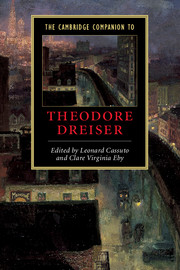Book contents
- Frontmatter
- Introduction
- Part I Backgrounds and contexts
- Part II Dreiser and his culture
- 5 The matter of Dreiser’s modernity
- 6 Dreiser, class, and the home
- 7 Can there be loyalty in The Financier? Dreiser and upward mobility
- 8 Dreiser, art, and the museum
- 9 Dreiser and women
- 10 Sister Carrie, race, and the World’s Columbian Exposition
- 11 Dreiser’s sociological vision
- 12 Dreiser and crime
- Select bibliography
- Index
12 - Dreiser and crime
from Part II - Dreiser and his culture
Published online by Cambridge University Press: 28 May 2006
- Frontmatter
- Introduction
- Part I Backgrounds and contexts
- Part II Dreiser and his culture
- 5 The matter of Dreiser’s modernity
- 6 Dreiser, class, and the home
- 7 Can there be loyalty in The Financier? Dreiser and upward mobility
- 8 Dreiser, art, and the museum
- 9 Dreiser and women
- 10 Sister Carrie, race, and the World’s Columbian Exposition
- 11 Dreiser’s sociological vision
- 12 Dreiser and crime
- Select bibliography
- Index
Summary
When Theodore Dreiser was finishing An American Tragedy in 1925, he found himself unsatisfied with the scene of Clyde’s execution at the end of the novel. In search of the specificity that fuels all of his writing, he sought to observe an actual death row at Ossining (“Sing-Sing”) State Prison in New York. The visit, brokered by his friend and supporter H. L. Mencken, was arranged by none other than James M. Cain, then a writer at the New York World. A few years later, Cain would turn from journalism to fiction, just as Dreiser had done a quarter of a century earlier. Cain’s first two novels, The Postman Always Rings Twice (1934) and Double Indemnity (1936), were stories of planned murder for love and money, and they shocked the literary community with their frank portrayals of greed, lust, and depravity. Like Dreiser - whose earlier novels had been attacked by such organizations as the New York Society for the Suppression of Vice - Cain found himself the object of a moralistic crusade to have his writing banned. And like Dreiser’s writing, instead of being suppressed, Cain’s work became influential. His novels continue to be read; today Cain is recognized as one of the founders of the hard-boiled school of crime fiction, a genre which features self-interested, emotionally hardened loners who navigate a morally degraded world.
- Type
- Chapter
- Information
- The Cambridge Companion to Theodore Dreiser , pp. 196 - 213Publisher: Cambridge University PressPrint publication year: 2004



